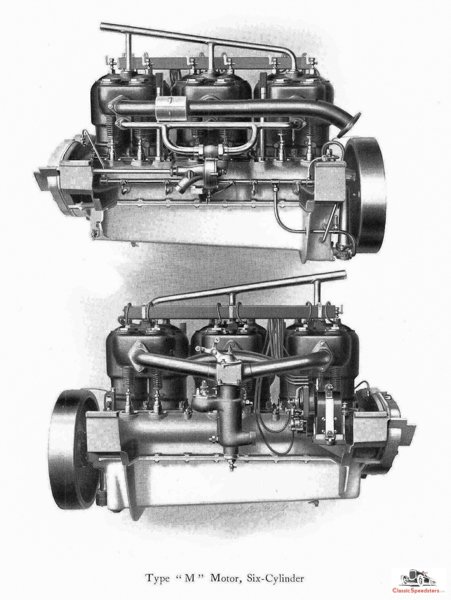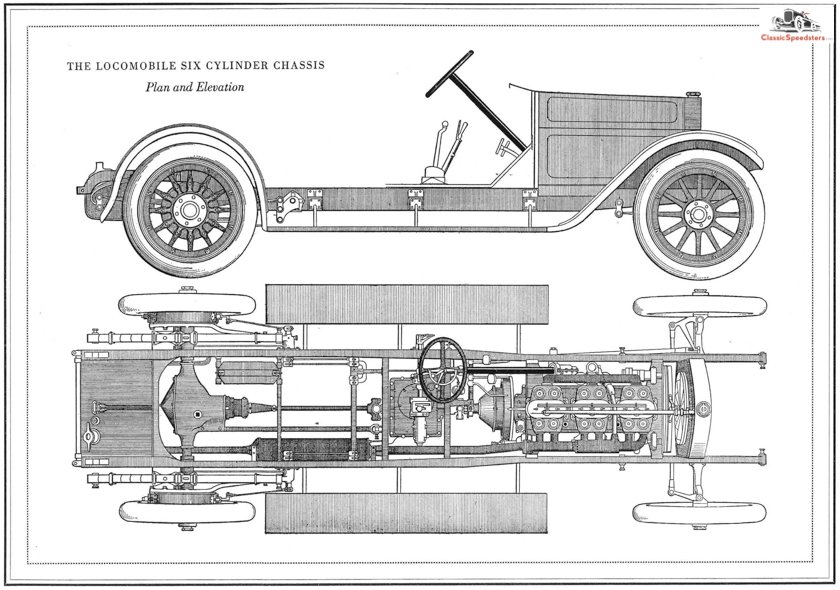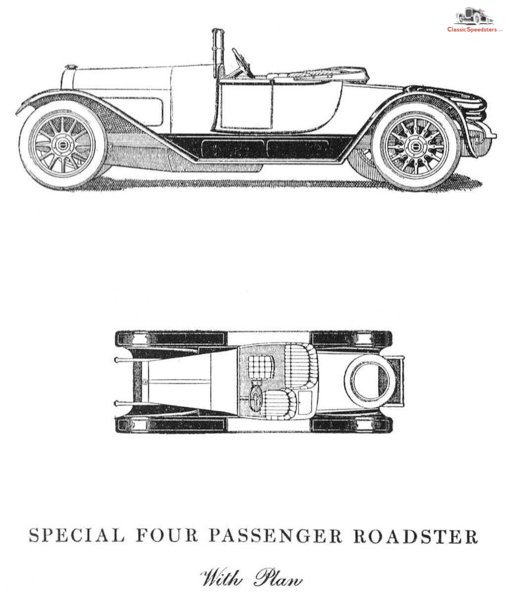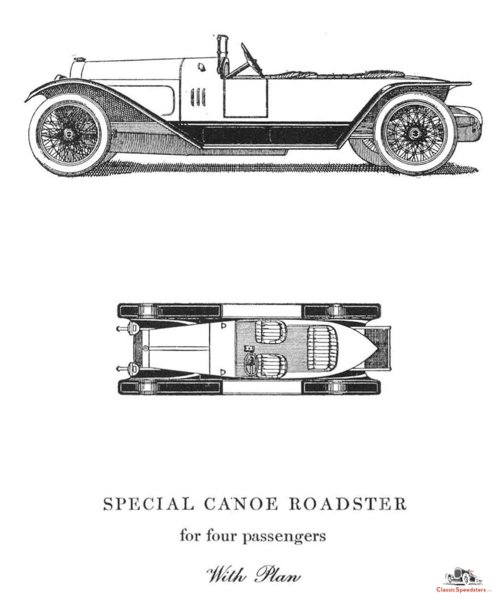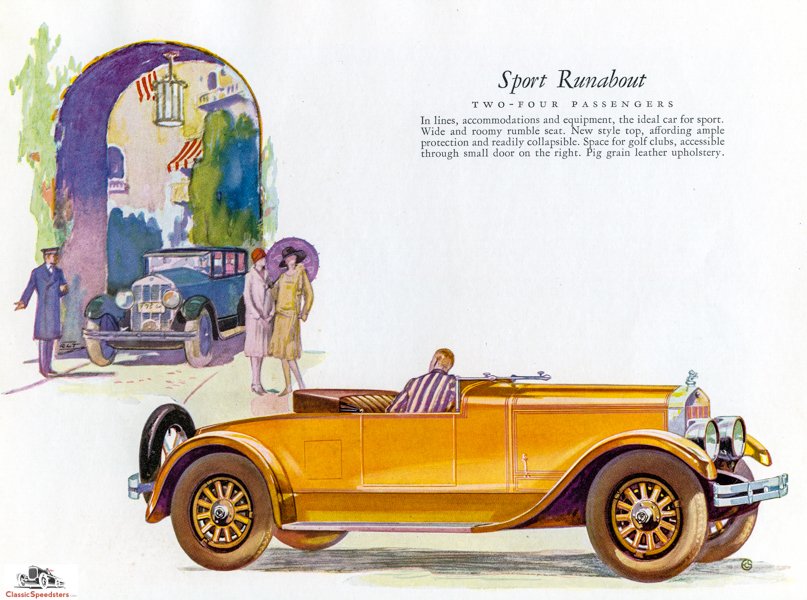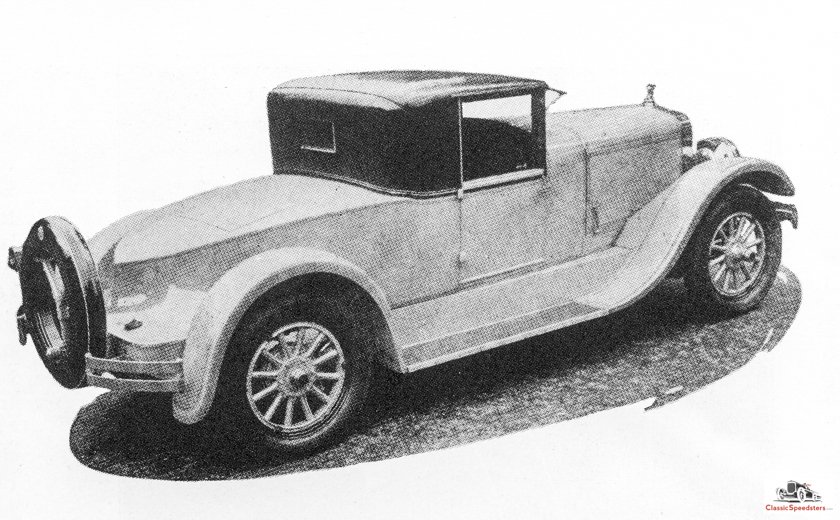After Effects
1908 Locomobile trophies. all images courtesy Horseless Carriage Foundation Library unless otherwise noted
Racers no doubt recognized the inherent ruggedness of the Locomobile platform. Although not extensively covered in articles that chronicled Locomobile’s story, the runabout model from 1908-1910 very likely served as a testbed in road endurance events, road race competitions, and even used by companies with which test their products.
1909 Locomobile race car action shot. Note the chain drive, typical for this era, and the wire fender support seen in front of the radiator. This was a bare-bones track speedster, sans lights, horn, and with only a front fender (wing) for the driver’s side. On this dusty road, the fender was not needed!
All of these were popular events that showcased what folks wanted in a car that they purchased: a rugged vehicle that would hold up under everyday conditions. And a perusal of the catalogs indicate that this was indeed true, as folks were using runabouts in a variety of conditions.
1910 Alaska Exploration Co car.
1910 Locomobile expeditioning in Maine.
Personalized runabouts, a.k.a. speedsters, were possible for Locomobile clients, since the bodies were created by local coachbuilders such as Waterhouse and Merrimac. This unidentified gentleman was photographed driving a Locomobile speedster outfitted for the street.
1907 Locomobile street speedster.
The Model 48 M
Locomobile had been refining its models and had pretty much perfected its four-cylinder offerings by 1910 with the Models 30 and 40, with the four phased out after 1913.
1911 Locomobile Type L engine.
For 1911 Locomobile introduced a six-cylinder engine with a T-head configuration but kept its en bloc construction, which of course meant three pairs of cylinders. The larger engine, known as the “M,” measured 4.5” X 5.5”, displaced 525 cubic inches, and produced over 80 horsepower in stock form.
1911 Locomobile Type M engine.
The smaller engine was used in the Model 38, measured 4.5” X 5.5”, displaced 477 cubic inches, and produced 63 horsepower in the 1914 edition. The 38 would continue until 1918 with a six-cylinder, after which the 48 became the sole model offered by Locomobile until 1925. The 48 and other,smaller models would continue until the tents folded on Locomobile in 1929.
Locomobiles were constructed of only the finest this-and-that, as witnessed in their catalogs.
Take, for instance, the chassis:
The Chassis Frame is constructed of pressed chrome-nickel alloy steel, heat
treated, six inches deep in the center, a strong and rigid substructure without an
ounce of unnecessary weight. All holes are drilled. Hot rivets are used.
The metals used ranged from bronze to manganese, to copper, to nickel. Why employ iron when steel would be better?
A … step in the Locomobile scheme is the selection of the finest material
for each particular part. The idea is to make the Locomobile better by using better
material. Bronze is used instead of aluminum; forgings instead of castings; and
expensive special steels take the place of common steels.
interiors were given special attention that only the upper crust could truly appreciate:
The interiors are upholstered in the finest broadcloths, velvets, velour, and worsteds,
of delicate pattern and unusual weave. Their beauty and variety enable one to possess
a car which is different from other cars, more beautiful and more artistic.
Hidden compartments held telephones for calling the driver, vanity cases, cigars, or whatnot. Silk lined the drawers, and windows were raised and lowered by a brand-new feature—the window crank! Lighting fixtures, of course, included selections from Tiffany.
All of this required a superb engine to power the carriage, and the “48” was designed to do just that.
The Locomobile motor is the six-cylinder type, chosen for its superior balance, accessibility, and smoothness of operation… A notable feature is the bronze engine
base, projecting arms of which extend to the frame and are securely bolted thereto, forming a structure of great strength and safety. The crankshaft is enormously strong,
of chrome nickel steel, one piece construction, ground and polished all over, and balanced. It rests in seven large main bearings. Locomobile cylinders are the finest gray iron castings, fully aged, and bored and ground to the utmost exactness. Pistons are provided with five expansion rings, four at the top and one at the bottom, the entire surfaces of which are ground. Connecting rods are Locomobile forgings, the lower caps being fastened with bolts instead of studs. Cooling is effected by a honeycomb radiator, the water being circulated by a gear driven centrifugal pump of bronze.
Not mentioned in the discussion, but a standard procedure used in all Locomobile engines, was the use of a cast bronze engine case, a forged steel crank, and an aluminum oil sump. The metals employed were the best choice for each application. In sum, the Model 48 T-head engine, like its predecessors, was built to last for at least 100 years!
1910 Model 30 crankshaft and case. All Locomobile engines were made in the same manner.
Locomobiles were refined each year to be a little bit better than previous years. They were built for the elites, and so only 1000 were made and sold each season during Locomobile’s salad days, from 1908 -1918.
1918 Locomobile chassis, showing components. This is what would be delivered to a coachbuilder.
A gifted designer named J. Frank deCausse had been spirited away from his position at a premier French carrosserie, Georges Kellner et Fils, in 1914. From this Locomobile became the first American auto firm with its own custom body shop and in-house designer. DeCausse has been credited with the invention of the boattail, as well as the dual-cowl phaeton, and his work would influence several other firms well on into the 1930s.
From deCausse’s drawing board at Locomobile would emerge a flurry of designs to broaden the collection offered there. One group would be the roadsters, one or two of which would have qualified to be called a “speedster.”
The Rise of the Gunboat Roadster-Speedster
In 1906-07 the Vanderbilt Racer had been offered for sale by the company. Along with that model, a sporty street speedster called the “Fishtail Runabout” had also been listed with the touring and limousine models. It used the Model E’s 93-inch wheelbase and the 15-20 horsepower four. Alas, no images exist for this model.
Starting in 1914 with the opening of the Custom Body Design Department, a series of roadsters of varying configurations would be offered. Locomobile itself would produce a running chassis and area coachbuilders such as Locke, Demerest, and Holbrook that were on retainer by Locomobile would build the bodies, either standard catalog or custom according to client specs.
Several choices were available for each of the body styles, the “roadster” configuration being one of them. All Model 48s of this era rode on a 142” wheelbase, so these were long and low.
1917 Locomobile 4-passenger Roadster. Model 48s rode on a 142” wheelbase from 1917-on.
1917 Locomobile Canoe Roadster, looking kinda sporty!
1917 Locomobile 3-pass Roadster.
1917 Locomobile Gunboat Roadster. This was also referred to as a “speedster,” but it was really the Big Six under the hood that gave this car its sizzle!
It’s apparent that the “Gunboat Roadster,” also referred to in Kimes’ Standard Catalog as a “Gunboat Speedster,” was one of the roadster designs that was assigned to make a sporty statement, a street speedster of sorts. Nevertheless, all roadster choices were essentially the same vehicle, just different configurations.
A lesser-known model, the 1915 Race-About, had been designed by deCausse as part of the 1915 lineup. Distinctly lower and more sporty-looking than its Roadster sibling, could the Race-About have inspired the 1917 Gunboat? It’s highly likely that it did, and this design, after deCausse had left the firm, would be carried in his portfolio to show up in other cars, such as the 1926 Franklin.
1915 Locomobile 48 Roadster. Based on a 140” chassis, this model stood a little taller in the saddle that later Model 48s.
1915 Locomobile 48 Race-About. Locomobile had commandeered the “Raceabout” name from Mercer to capture its speedster mojo in this model. It appears to be lower than its Roadster sibling. Were any of these made?
As Locomobile started to falter in 1921, deCausse had departed and opened his own design office. He would do a major facelift for Franklin cars in 1924, creating the Series 11 and causing its chief engineer, John Wilkinson, to resign in protest. Wilkinson had formerly been in charge of design at Franklin and had made some bad design choices, such as the “55-gallon drum” engine cover—yuk!
DeCausse, and then Dietrich, would vastly improve the Franklin look.
1926 Franklin Sport Runabout. DeCausse had redesigned the Franklin engine cowl and assigned it a faux radiator and grill to make it look like “other” cars. Keep in mind that Franklins were air-cooled and didn’t use a radiator. Chief engineer Wilkinson blew a head gasket over this facelift; sore loser….
1926 Sport Runabout rear oblique. A boattail was derigueur for all sporting cars of this era, and some did them better than others. This was deCausse’s version for Franklin.
DeCausse would also develop designs for William C. Durant’s “Flint” automobile and do private contracts for custom one-off bodies. Unfortunately, deCausse would die in 1928 at the age of 48 from throat cancer.
Things Fall Apart
It would take a book to explain all of the twists and turns that Time and Fate put Locomobile through in the span of just ten short years. A Cliff’s Notes version indicates that in 1919, Albright (as general manager) overspent from the company’s coffers to purchase materials in anticipation of a boom in the auto market, which was not a bad hunch, as most post-war years create an upsurge in consumerism. However….
The depression of 1920-21 laid all of that to waste. Plus, Albright had sold the company to Emlen S. Hare and his management team, who were planning to build a conglomerate based on Mercer, Simplex, and Locomobile. On paper, it was a great idea, but the depression, the over-extension of capital, and a lack of consumer interest put the kibosh on sales and cash flow. This empire sank, and Locomobile was rescued only after it disengaged from Hare’s partnership.
Then William C. Durant, still smarting from losing control of General Motors (for the second time), came courting. His plan was better founded and accepted. Durant’s conglomerate, of which Locomobile was the luxury car component, was successful—until 1929. Another crash, and with it Locomobile and the rest of the economy wrecked.
There was a time and place in the sun for Locomobile, and the Model 48 M Gunboat Roadster and its other speedsterish siblings said it all as they drove in those halcyon days of the prewar nineteen teens. Unfortunately, time passes, and so too did Locomobile.
**************************************** *********** *************************************
Next post we’ll look at a company whose speedster dalliance was brief but historic in its impact. Plus, the company would last for over 100 years!








